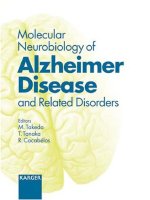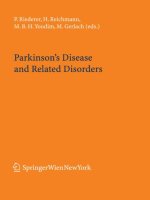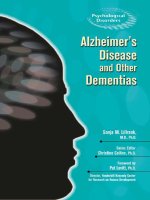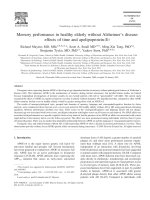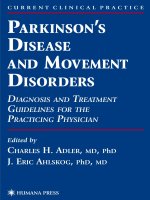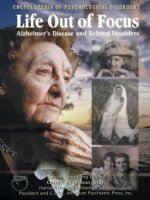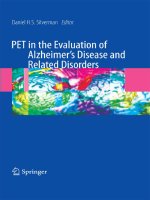LifeOut of Focus Alzheimer’s Disease and Related Disorders ppt
Bạn đang xem bản rút gọn của tài liệu. Xem và tải ngay bản đầy đủ của tài liệu tại đây (2.37 MB, 105 trang )
Life Out of Focus
Alzheimer’s Disease and Related Disorders
■ Anorexia Nervosa:
Starving for Attention
■ Child Abuse and Neglect:
Examining the Psychological Components
■ Conduct Unbecoming:
Hyperactivity, Attention Deficit, and Disruptive Behavior Disorders
■ Cutting the Pain Away:
Understanding Self-Mutilation
■ Drowning Our Sorrows:
Psychological Effects of Alcohol Abuse
■ Life Out of Focus:
Alzheimer’s Disease and Related Disorders
■ The Mental Effects of Heroin
■ Psychological Disorders Related to Designer Drugs
■ Psychological Effects of Cocaine and Crack Addiction
■ Schizophrenia:
Losing Touch with Reality
■ Sibling Rivalry:
Relational Disorders Between Brothers and Sisters
■ Smoke Screen:
Psychological Disorders Related to Nicotine Use
■ Through a Glass Darkly:
The Psychological Effects of Marijuana and Hashish
■ The Tortured Mind:
The Many Faces of Manic Depression
■ When Families Fail:
Psychological Disorders Caused by Parent-Child Relational Problems
■ A World Upside Down and Backwards:
Reading and Learning Disorders
THE ENCYCLOPEDIA OF PSYCHOLOGICAL DISORDERS
Senior Consulting Editor Carol C. Nadelson, M.D.
Consulting Editor Claire E. Reinburg
CHELSEA HOUSE PUBLISHERS
Philadelphia
THE ENCYCLOPEDIA OF
PSYCHOLOGICAL DISORDERS
Dan Harmon
Li fe Out of Focu s
Alzheimer’s Disease and Related Disorders
Chelsea House Publishers
Editor in Chief: Stephen Reginald
Managing Editor: James D. Gallagher
Production Manager: Pamela Loos
Art Director: Sara Davis
Director of Photography: Judy L. Hasday
Senior Production Editor: Lisa Chippendale
Staff for PSYCHOLOGICAL EFFECTS OF COCAINE AND CRACK ADDICTION
Editorial Assistant: Lily Sprague, Heather Forkos
Picture Researcher: Sandy Jones
Associate Art Director: Takeshi Takahashi
Designer : 21st Century Publishing and Communications, Inc.
Cover Design: Brian Wible
© 1999 by Chelsea House Publishers, a division of Main Line Book Co.
All rights reserved. Printed and bound in the United States of America.
The ChelseaHouse World Wide Web site address is
First Printing
9 8 7 6 5 4 3 2 1
Library of Congress Cataloging-in-Publication Data
Harmon, Dan.
Life out of focus: Alzheimer’s disease and dementia / by Dan Harmon.
p. cm. — (Encyclopedia of psychological disorders)
Includes bibliographical references and index.
Summary: Discusses the nature, possible causes, effects on the patient as well as family
and friends, and treatment options of this deteriorative disease.
ISBN 0-7910-4896-9
1. Alzheimer’s disease—Juvenile literature. 2. Dementia—Juvenile literature.
3. Alzheimer’s disease—Patients—Family relationships—Juvenile literature.
[1. Alzheimer’s disease. 2. Diseases.] I. Title. II. Series.
RC523.H37 1998 98-26537
616.8’31—dc21 CIP
AC
The ENCYCLOPEDIA OF PSYCHOLOGICAL DISORDERS provides up-to-date
information on the history of, causes and effects of, and treatment and
therapies for problems affecting the human mind. The titles in this series are not
intended to take the place of the professional advice of a psychiatrist or mental
health care professional.
CONTENTS
Introduction by Dr. Carol C. Nadelson, M.D. 6
Alzheimer’s Disease: An Overview 9
1 Two Friends 11
2 The Critical Issues: Age and Memory 23
3 Understanding the Disorder 31
4 The Effect on Society 41
5 The Challenge of Diagnosis 51
6 P
ossible Causes of the Disease 65
7 Treatment of Alzheimer’s Disease 73
8 Coping Strategies for Caregivers 83
Appendix: For More Information 89
Appendix: National Alzheimer’s Disease Centers 90
Bibliography 93
Further Reading 95
Glossary 97
Index 100
T
here are a wide range of problems that are considered psychological
disorders, including mental and emotional disorders, problems
related to alcohol and drug abuse, and some diseases that cause both
emotional and physical symptoms. Psychological disorders often begin in
early childhood, but during adolescence we see a sharp increase in the
number of people affected by these disorders. It has been estimated that
about 20 percent of the U.S. population will have some form of mental
disorder sometime during their lifetime. Some psychological disorders
appear following severe stress or trauma. Others appear to occur more
often in some families and may have a genetic or inherited component.
Still other disorders do not seem to be connected to any cause we can yet
identify. There has been a great deal of attention paid to learning about
the causes and treatments of these disorders, and exciting new research
has taught us a great deal in the last few decades.
The fact that many new and successful treatments are available makes it
especially important that we reject old prejudices and outmoded ideas
that consider mental disorders to be untreatable. If psychological
problems are identified early, it is possible to prevent serious conse-
quences. We should not keep these problems hidden or feel shame that we
or a member of our family has a mental disorder. Some people believe that
something they said or did caused a mental disorder. Some people think
that these disorders are “only in your head” so that you could “snap out of
it” if you made the effort. This type of thinking implies that a treatment is
a matter of willpower or motivation. It is a terrible burden for someone
who is suffering to be blamed for their misery, and often people with psy-
chological disorders are not treated compassionately. We hope that the
information in this book will teach you about various mental illnesses.
CAROL C. NADELSON, M.D.
PRESIDENT AND CHIEF EXECUTIVE OFFICER,
The American Psychiatric Press
PSYCHOLOGICAL
DISORDERS
AND THEIR EFFECT
6
7
The problems covered in the volumes in the ENCYCLOPEDIA OF
PSYCHOLOGICAL DISORDERS were selected because they are of particular
importance to young adults, because they affect them directly or because
they affect family and friends. There are individual volumes on reading
disorders, attention deficit and disruptive behavior disorders, and
dementia—all of these are related to our abilities to learn and integrate
information from the world around us. There are books on drug abuse
that provide useful information about the effects of these drugs and treat-
ments that are available for those individuals who have drug problems.
Some of the books concentrate on one of the most common mental disor-
ders, depression. Others deal with eating disorders, which are dangerous
illnesses that affect a large number of young adults, especially women.
Most of the public attention paid to these disorders arises from a
particular incident involving a celebrity that awakens us to our own
vulnerability to psychological problems. These incidents of celebrities
or public figures revealing their own psychological problems can also
enable us to think about what we can do to prevent and treat these types
of problems.
hink for a moment about all the places you have been, the people
you have met, and the good times you have shared. Can you imagine
what life would be like if you had never done any of those things or
met any of those people? Take it a step further: think about everything you
have learned—even the simplest things: names of objects, such as “chair”
or “book,” for example. Now imagine that you can no longer access that
information—it has been “unlearned.” If this happened to you, chances
are you would feel very lonely, very confused, and very afraid.
Sadly, there are an estimated five million people in the United States who
feel exactly this way. They are the victims of a terrible disease called
Alzheimer’s, which strips away a person’s memory and experiences, changes
that person’s personality, and eventually prevents him or her from doing
even simple tasks without help. It is the most common of a group of disor-
ders that affect the elderly, known collectively as “senile dementia,” that
share many of the same characteristics. Alzheimer’s is a progressive disease;
this means that the condition continues to get worse over five to ten years.
Alzheimer’s disease is listed as the cause of more than 100,000 deaths
a year. Statistics show it is the fourth-leading killer among the adult
population. It accounts for roughly half the admissions to nursing
homes in the United States. The Alzheimer’s Association estimates that
American society spends an estimated $100 billion a year in Alzheimer’s-
related costs, and the federal government spent nearly $350 million on
Alzheimer’s research in 1998. But the greatest cost may be the emotional
toll the disease takes on the families of Alzheimer’s victims. More than
seven out of ten people with Alzheimer’s disease live at home, and almost
75 percent of the home care is provided by family and friends.
This book provides information about what, exactly, Alzheimer’s
disease is. It examines the possible causes of Alzheimer’s, its effect on the
person who is afflicted with the disorder and on family and friends
around him or her, and the current methods of treating the disease.
Unfortunately, there is no way to cure Alzheimer’s disease; however,
with continued research efforts, someday scientists may be able to counter
or eliminate the effects of this dreaded killer.
9
ALZHEIMER’S DISEASE:
AN OVERVIEW
Alzheimer’s disease affects the brains of older people. The disorder gradually causes a loss of
memory, leaving its victims confused and unable to care for themselves.
T
he following story is about two friends, Helen and Mary, who were
brought together because of the terrible disease that struck them both:
Alzheimer’s. It is sad, but it illustrates a problem that will probably affect
a friend or loved one of yours someday. Most people’s lives will be touched
somehow by Alzheimer’s disease. The more we can learn about this great
tragedy of American health, the better we can help the victims of Alzheimer’s
disease and those who live with and care for them.
THE END OF A CAREER
Helen and her husband were looking forward to retirement. Helen, 56, was
a professional financial planner. She was very intelligent, successful, and well
respected in her community. At home, she and her husband especially enjoyed
spending time with their six grandchildren. There, Helen could put numbers
and finances and tax forms aside, and devote all her energy to happily spoiling
the little ones.
The first sign of a problem was a gradual loss of her ability to calculate.
This perplexed and startled Helen, because she had always possessed the keen
mind of a mathematician. In the past, she had been able to multiply and divide
large numbers in her head, and resorted to a calculator only when she wanted
to show an “official” solution to one of her clients. Now, she found herself
using the calculator more often.
Over the next two or three years, there were other signs that something was
wrong. She had to use the calculator to solve basic math problems. Eventually,
she reached the point where she wasn’t even sure whether a problem called
for multiplication or addition, division or subtraction. There were lapses
of memory that were more embarrassing as well. Helen’s mind would go
blank when she started to greet certain friends by name. In time, she began
11
1
TWO FRIENDS
having trouble getting the names of her relatives straight. She had
difficulty expressing herself, finding the words to say exactly what
she wanted to say. She had once been an immaculate housekeeper,
but tidiness didn’t seem to concern her as much anymore.
As her mental condition slowly worsened, she and her husband both
worried about what was happening. Helen agreed to see a doctor for
testing. The results were very disturbing. For example:
• Helen had to think hard when asked to name the president of
the United States.
• When asked her age, she overstated it by several years. Then
she realized the mistake and corrected herself.
• She had difficulty remembering the month of her birth.
• Providing the names and ages of her five grown children was
a lengthy ordeal.
After an additional period of extensive physical and mental tests,
doctors concluded that Helen was probably suffering from Alzheimer’s
12
LIFE OUT OF FOCUS: ALZHEIMER’S DISEASE AND RELATED DISORDERS
A gradual loss of memory,
affecting a person’s skills and
behavior, characterizes
Alzheimer’s disease. In Helen’s
case, she slowly lost her ability
to calculate complex financial
statements—a skill that she had
developed over years as a pro-
fessional. Many other talented
victims of Alzheimer’s have to
deal with similar problems.
disease. She was in good physical health, which eliminated physical
causes, such as circulatory problems, an infection of the nervous system,
or a brain tumor, as reasons for her mental decline. The signals clearly
pointed to some form of dementia, which is a mental disorder characterized
by a loss of intellectual abilities such as memory, judgment, and abstract
reasoning skills, as well as by personality changes. The doctors categorized
Helen’s dementia as Alzheimer’s.
Helen and her husband had both secretly suspected that this might be
her problem, but they had never admitted their fears to each other. They
returned home in shocked silence. The doctors had confirmed what they
already knew: the disease was incurable. Helen’s condition would slowly
but inexorably get worse.
Helen began to write down her thoughts about what was happening to
her. Her journal touched the hearts of everyone who read it later.“I have lost
control of my life,” she acknowledged. “Until a year or two ago, I could solve
problems for other people. Now I cannot even prepare my own dinner with-
out creating a disaster. My days are spent wandering and wondering.”
One of her children also kept a journal. It, too, was filled with emo-
tion: “We are watching Mom die, a day at a time.”
As it turned out, Helen’s husband died first, felled by a sudden heart
attack. Her children, all busy professionals, hired a companion to keep an
eye on Helen and make sure that she was safe. The companion, not famil-
iar with the effects of Alzheimer’s, thought it curious that Helen would
sometimes speak of her dead husband as though he had only gone out to
the grocery store. It was also strange, the nurse thought, that with her full
wardrobe of nice clothes Helen would wear the same outfit day after day.
As Helen’s mental condition grew worse, she became withdrawn
and careless. She would often forget to pay monthly bills. Her deterio-
rating personal health and lack of toilet discipline became a problem
too serious for the companion to handle. Once an attractive, well-
groomed professional, Helen seemed to have forgotten all about her
appearance. Perhaps the problem was that she simply couldn’t remember
how to dress herself properly.
In the hallway of her home hung a large mirror. Helen would often
stop in front of the mirror and stare at her own image. To her, the face
in the mirror seemed to be that of a complete stranger. “Who is that
other woman who’s staying here with us now?” she would ask her com-
panion, sometimes several times a day. No one could convince her that
the woman in the mirror was herself.
TWO FRIENDS
13
Late one night, police found Helen wandering the streets several
miles from home. She was dressed in her bathrobe. She was very glad to
see them, she told the officers. “Have you seen my husband? I’ve been
looking for him everywhere. We have to find him and tell him he has a
telephone call.”
A year after their father’s death, Helen’s children decided to have her
admitted full-time to an assisted-living facility. They were relieved when
Helen seemed to accept the idea—at first. But when moving day came,
she fought violently to remain in her home. She accused her children of
driving her out against her wishes. In time, Helen became somewhat
accustomed to her new surroundings. But she frequently begged to
return home.
As time passed and Helen remained in the nursing home, her closest
friends and family members began to look like strangers to her. Her
memory loss was heartbreaking and frustrating for the people who
loved her. For example, her son would enter her room.
“Who are you?” she would ask, surprised.
“I’m Arthur, your son.”
“Oh, it’s so good to see you. I need some water. Now!”
Arthur would return with a cup of water.
“Thank you,” Helen would say, gulping it down. “Now,
Mama, get me out of here. Please get me out of here.”
“Mother, it’s me, Arthur.”
“Yes. Please get me out of here. Mama, I want to go home now.”
“This is your home, Mothe
r
.”
“No. This is not my home. Where is Daddy?”
“Dad died several years ago.”
“No, he didn’t. Who are you?”
Arthur would excuse himself and leave the building, blinking back tears.
A NEW BEGINNING—A TRAGIC END
Mary was the wife of a career Air Force officer. For more than 30 years
her husband Vince had been transferred from base to base around the
world. She had raised their children in various areas of the United States
and in several foreign countries.
14
LIFE OUT OF FOCUS: ALZHEIMER’S DISEASE AND RELATED DISORDERS
The children were all grown and on their own when her husband
retired from the military. This gave her a chance to pursue her
favorite interest: painting. She was a greatly gifted artist, but had
never had the time to study or fully develop her skills. She enrolled as
a full-time student in a local art college and at age 58 she obtained
her degree in art. By that time, some of her works were already being
sold in galleries and exhibits.
TWO FRIENDS
15
As the memory of a patient with Alzheimer’s disease continues to decline, close
friends and family members may begin to look like strangers.
One morning when she entered her small, cheerful studio to work,
she found herself disoriented. She stared at the unfinished canvas she
had intended to complete that day. It looked strange. She had no idea
how she had wanted the final image to appear. Later that day, she was
able to complete the painting and resume her work as if nothing was
wrong. She put the troubling incident from her mind. She simply hadn’t
been feeling well, she told herself.
In the next few months, small incidents of forgetfulness began to add
up to a changing personality. Mary would leave her studio to walk into
another room of the house—and forget what she went there to do or to
find. “I have too many things on my mind,” she thought at first. But
eventually she began to wonder what was happening to her.
Her family and friends began to notice disturbing changes in her
behavior. She would forget where she had left common objects, and
sometimes would confuse people’s names. Sometimes her attention
seemed to wander a million miles away, and the person speaking to
Mary would have to call her by name or touch her shoulder to bring her
back into the discussion. Mary could usually rejoin the conversation as
if she had been listening all along—or could at least “fake it” so that
nothing seemed amiss.
Mary had an uncanny ability to disguise her problem. Her most
useful device was to change the subject when the attention turned to
her. She would begin talking about a familiar topic. The change might
seem abrupt to her companions, but it usually got her off the hook.
One of her friends would take up the new subject of conversation, and
Mary would withdraw into her private, mysterious realm of thought.
Eventually, Mary stopped trying to fake it. She would simply stare at
the person who asked her a question, or would excuse herself and go to
the bathroom.
When she was unable to find her parked car after shopping at a mall
one day, she began to cry. A security official summoned her husband from
home. That was the day Vince gently suggested she undergo a routine
medical checkup. Mary knew, of course, the reason for his concern. She
resisted. “There’s nothing wrong with me,” she told him. “I’m just getting
older. We both are. We can expect things like this to happen occasionally.”
But “occasionally” became “frequently” over the next two years. Her
memory, orientation, and communication skills worsened. Worried friends
would telephone her husband, describing Mary’s dangerous driving habits
16
LIFE OUT OF FOCUS: ALZHEIMER’S DISEASE AND RELATED DISORDERS
and her strange behavior. “She pretended she didn’t even recognize me
when I saw her at the supermarket,” they would report.
Mary would telephone her children and friends many times a day. If
they weren’t home, she would leave them voice mail messages—repeat-
edly. On one occasion, neighbors saw her trying to drive her car while
sitting in the passenger’s seat!
One afternoon when Mary was home alone, her son telephoned her.
He was alarmed when she failed to answer the phone, and drove
quickly to her home. She was sitting in her living room, gazing blankly
into the fireplace. She didn’t recognize him and didn’t seem to know
where she was.
As the disease progresses,
a person with Alzheimer’s
will lose interest in hob-
bies or pastimes that
were once important to
him or her. This change
may be difficult for that
person’s friends and
relatives to understand.
TWO FRIENDS
17
Mary grew increasingly impatient and agitated. When she had to wait
for things to happen, she would pressure those around her to hurry—
even if the situation was outside their control. No one could make her
understand why certain things took time.
Supported by their children and pastor, her husband firmly insisted
that she seek testing and help. By that time, test results suggested, Mary
was already into an advanced stage of Alzheimer’s disease. It was time for
her to accept the sad news those around her already expected.
When they took away her driving privileges, it was a terrible turning
point. Mary felt deprived of her freedom—in a way, of her very life.
From that point, it seemed to her family that her condition worsened
more rapidly.
For two more years, Mary was able to live at home. She even completed
a few remarkable paintings. But she rarely finished the work she started.
Her interest in art diminished. Days would pass between studio work
sessions, then weeks. She stopped cooking. Her husband rarely let her
walk around the neighborhood alone, because when she did she usually
got lost. She required more and more assistance with her personal care
and upkeep. Her husband, who was beginning to experience health
problems of his own, was feeling added stress because of the situation.
All of their children lived out of state and could offer little help.
Ultimately, Mary had to be admitted to a residential care facility. The
decision was an emotional ordeal for her family. Surprisingly, it didn’t
seem to matter much to Mary at that point. She said little the day they
settled her into her room, surrounded by her art and familiar mementos.
“Who painted that picture?” she asked one of her daughters,
pointing.
“You did, Mother,” came the choked reply.
“Oh, yes. I know. We were living in Scotland. I loved Scotland.”
Her daughter hesitated, then corrected her. “No, Mom. You
painted that one just a few years ago. It was while you were
taking art classes at the university. Don’t you remember?”
But by then her mother was ransacking the drawer of her
night table. “Where are my car keys? I need to go to the super-
market. Aunt Katherine is coming today.”
Aunt Katherine, her daughter knew, had died 20 years before.
18
LIFE OUT OF FOCUS: ALZHEIMER’S DISEASE AND RELATED DISORDERS
FRIENDS AT THE CLOSE OF LIFE
It was at the nursing home that Mary and Helen met. They shared a
table in the dining hall. For the first few months, they would talk together
about art, music, flowers, and celebrities or world leaders who had
impressed both of them a generation earlier. Helen, a gifted pianist, would
perform in the home’s common room. Mary and the other residents loved
to hear her play. To a visitor, it might appear that they all were ordinary people
thoroughly enjoying their latter years in the company of kindred spirits.
TWO FRIENDS
19
Eventually, victims of Alzheimer’s disease require help with the simplest tasks, and must
be moved into a nursing home or care facility where they can be overseen constantly.
This is hard on family members, who may realize on one hand that they can no longer
take care of their relative, while on the other hand hating the idea that their loved one is
away from his or her home and surrounded by strangers.
But on closer observation, unusual behavior became obvious. Mary
and Helen would speak of long-dead relatives and friends, anticipating a
visit from them shortly. Sometimes they seemed to carry on separate
conversations at the same time. The response to a comment by one
would be a complete change of subject by the other. To an unfamiliar
observer, their conversations would make little sense. Yet Helen and
Mary were relaxed and happy simply being in each other’s company.
They were two friends who unknowingly—or perhaps they did know—
faced the same bleak end to their lives.
As they became more childlike in their behavior and less able to com-
municate, the relationship waned. Helen was confined to her room. It
hardly seemed to matter, for she appeared unaware of where she was
from day to day. Mary, too, mostly remained in her room.
During the final year of Helen’s life, entries from her daughter’s diary
went like this:
Friday: Mother seems more confused each day. She thinks I am her
mother, not her daughter. Most days, she believes she is visiting me!
As far as she knows, she is a young girl. I think she wonders why I
call her “Mother.”
Tuesday: She usually is asleep, or dozing in and out of dreams,
whenever I visit. When she is awake, she confuses her dreams with
real life.
Thursday: All of us took mother out to dinner. We made reserva-
tions at the restaurant that used to b
e her favorite. She did not know
where we were, but she seemed to enjoy the food and the evening.
Although she did not remember the restaurant, it seemed to bring
back memories of people she used to know and things they used to
do together. She loved the ice cream dessert.
Friday: Mother begged me to take her to play golf. She hasn’t played
golf for at least 10 years.
Saturday: She didn’t speak at all. I couldn’t get her to answer any of
my questions. So I just sat beside her bed and watched as she tossed
about and stared at the opposite wall. It was as if she was asleep, suf-
fering a bad dream. But her eyes were open.
Toward the end, there was little for her daughter to record in the
diary. When she visited Helen, there was only stillness. And silence.
Helen and Mary died within a month of each other, two years after
20
LIFE OUT OF FOCUS: ALZHEIMER’S DISEASE AND RELATED DISORDERS
they had retired to their rooms. The immediate cause of death for both
was pneumonia, which often develops when patients are bedridden for a
long time. For most of their last year, they had each remained in their
beds, night and day. They required total care. Neither spoke coherently
to their families or to the medical staff.
In the final months, they never spoke at all. They hardly even moved.
■■■
Alzheimer’s disease is a disease of the brain that generally affects
older people. It is the most common of a group of disorders, known as
“senile dementia,” that share many of the same characteristics. As the
stories above illustrate, the first signs of dementia are slight memory
disturbances or subtle changes in personality. Alzheimer’s is a progres-
sive disease; this means that the condition continues to get worse with
time. Usually, Alzheimer’s disease gets progressively worse over five to
ten years.
In the stories above, both victims of Alzheimer’s disease were
women. This is quite common: women are afflicted with Alzheimer’s
more frequently than men. It is also very common for family members
to take care of a loved one with Alzheimer’s for as long as they are able.
The disease’s greatest effect may not be on the victims, but on the esti-
mated 12 million people who are caregivers for an Alzheimer’s patient.
Alzheimer’s disease is the fourth-leading killer among the adult
population, causing more than 100,000 deaths each year. About half of
the people admitted to nursing homes in the United States are suffering
from Alzheimer’s.
It’s estimated that between 2 and 4 percent of Americans older than
65 have Alzheimer’s disease. The percentage rises sharply as age increases.
An estimated 20 percent of Americans over age 85 have Alzheimer’s,
notes the Diagnostic and Statistical Manual of Mental Disorders, fourth
edit
io
n (a widely recognized authority on psychological disorders, also
referred to as the DSM-IV). The Ame
rican Psychiatric Press Textbook of
P
sychiatry suggests the rate among those older than 85 may be as high as
47 pe
rcent.
As the average age of the population increases, the percentage of
Alzheimer’s patients in our society will undoubtedly increase. Unless we
find an effective way to treat and prevent the disease, the number of its
victims is expected to nearly quadruple over the next 50 years.
TWO FRIENDS
21
Alzheimer’s is a disease of the elderly: most people with the disorder are age 65 or older, and
very few cases occur in people younger than 50. As a person ages, the likelihood of developing
Alzheimer’s disease rises. Between 20 and 47 percent of people over 85 years old are believed to
have the disease.
B
efore exploring Alzheimer’s disease in detail, it is necessary to under-
stand the central, common elements it involves—age and memory. The
disease is mysterious, but one thing that doctors know for certain is that
it affects older people much more commonly than young adults. It was origi-
nally believed to afflict only persons in their fifties or sixties. Although some
cases have been found in younger adults, Alzheimer’s poses no threat for small
children or teenagers.
The second factor to consider is human memory. Memory loss—one of
the most obvious and distressing symptoms of Alzheimer’s disease—is
much more serious than forgetting the answers on a history exam or getting
distracted by a TV sitcom and neglecting to finish your homework. In
Alzheimer’s cases, loss of memory cuts the victims off from people, places,
and events that they love, essentially destroying their identities. A factor
related to memory is a person’s ability to learn new things. This, too, is grad-
ually lost to Alzheimer’s victims.
EVERYONE GROWS OLD—SO WHY ALL THE FUSS?
Why are Alzheimer’s and other similar forms of senile dementia such
important concerns today? After all, our great-grandparents’ generation did
not worry much about the symptoms of dementia in older people; they
regarded memory loss and personality changes as a common part of the
aging process.
It’s important to remember that Alzheimer’s disease has come to public
notice as the population has grown older. People today expe
ct to li
ve longer
(and stay healthier longer) than people did a century ago. A greater percentage
of our population is “old” today than in previous generations. In 1900, just one
out of 25 Americans (4 percent) were past our standard retirement age, 65. By
23
2
THE CRITICAL ISSUES:
AGE AND MEMORY
1998, nearly 13 percent of the U.S. population were age 65 or older.
Because Alzheimer’s disease typically affects older people, it’s under-
standable that a few decades ago—when the population’s average age
was significantly lower—Alzheimer’s wasn’t recognized as a major
health and “quality of life”problem, as it is now. At that time, when serious
mental lapses were observed in an older person, the individual was
often said merely to have grown “senile”—a condition that came to be
expected in the elderly.
Today we know this pronouncement is simplistic and inaccurate. In
the 1970s, great progress was made in understanding and treating
physical and mental ailments common to the elderly. A major reason
for the trend toward a “grayer” population is that modern science and
medicine provide ways to keep people healthier and help them live
longer. This has led to new emphasis in medical studies: now that more
24
LIFE OUT OF FOCUS: ALZHEIMER’S DISEASE AND RELATED DISORDERS
Senile dementia and Alzheimer’s disease are important problems today in part because
the overall population is getting older. About 13 percent of the U.S. population is over age
65, compared to just 4 percent a century ago.
